The Brazos Review: AMD's E-350 Supplants ION for mini-ITX
by Anand Lal Shimpi on January 27, 2011 6:08 PM ESTHeavy Lifting: Performance in Complex Workloads
Brazos is clearly faster than Atom in light workloads, but what about in more complex/heavier applications? Are the Bobcat cores enough to allow E-350 systems to move up in the world or will they still be confined to the web browsing/email usage models of netbooks? I've run the E-350 through our entire Bench suite to find out. If you want the full gamut of results head over to CPU Bench, but I've chosen a few here. I also included performance results from a 2.66GHz Pentium 4 to put things in perspective for users of really old systems.
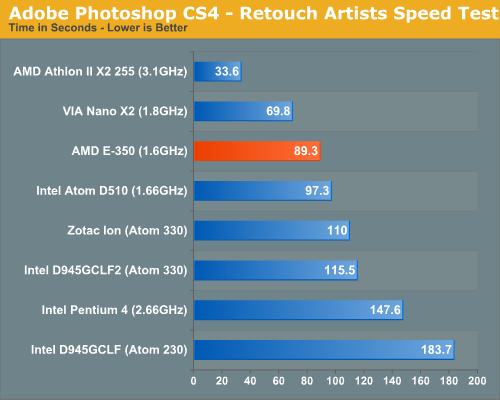
Photoshop CS4 performance is not half bad on the E-350 compared to other similarly priced platforms. Also impressive is the E-350's performance advantage over the old Pentium 4. Compared to the Athlon II X2 however the E-350 is still noticeably slower.
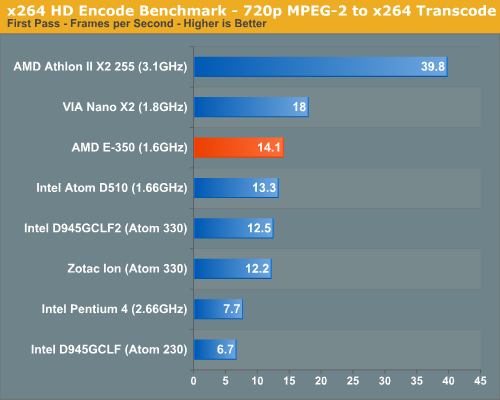
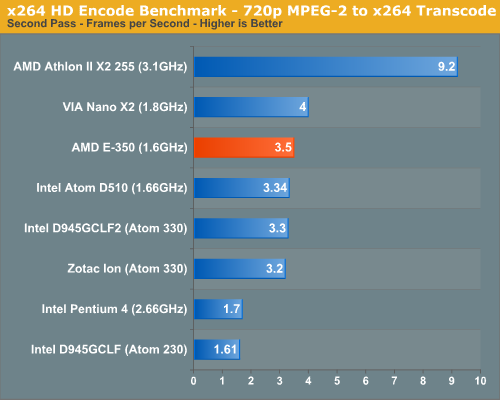
The standings and performance trends continue in our x264 encode benchmark. I don't expect you to do a lot of video transcoding on the E-350 as it's not much faster than Atom here. VIA's dual-core Nano is a bit quicker but still not enough to make this a viable usage case.
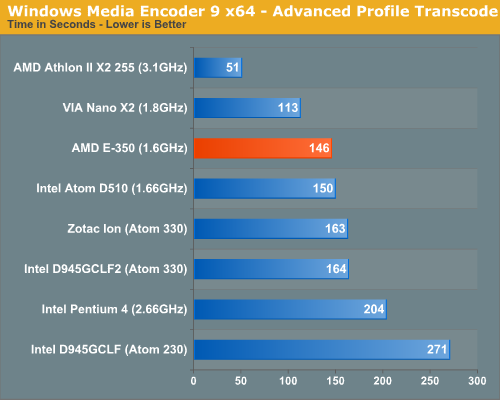
Windows Media Encoder provides a far lighter workload, but the standings don't change. The E-350 is faster than anything Atom based, faster than the old Pentium 4, but slower than VIA's Nano X2.
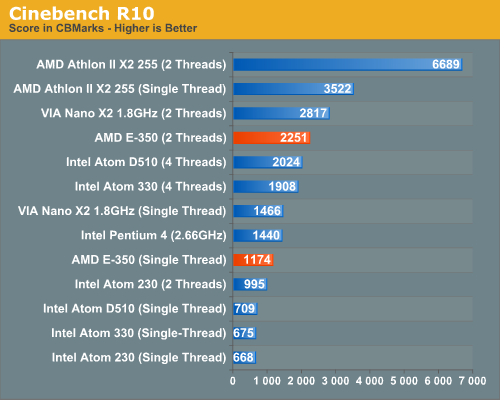
While I don't expect E-350 users to do any offline 3D rendering work, Cinebench does give us a good characterization of single threaded performance. The problem with Atom is that its single threaded performance isn't nearly as good as its multithreaded performance. In all of the previous benchmarks an Atom D510 is clearly quicker than the old 2.66GHz Pentium 4, but looking at single threaded Cinebench R10 you get a different story entirely. The P4 has nearly twice the single threaded performance of an Atom D510.
The E-350 is still a bit behind the Pentium 4 in single threaded performance, but it's not nearly as bad as Atom. The out-of-order execution engine helps tremendously here. What you get as a result is a system that doesn't really feel slower than a 5 year old PC but has the features of a more modern system.
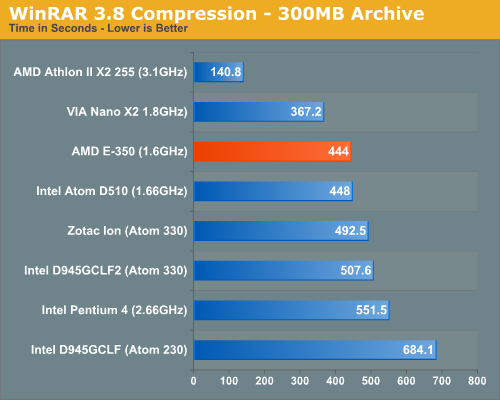
Overall the E-350 is clearly faster than Atom ever was at running these heavier workloads. The highly threaded workloads aren't much faster on E-350 vs. Atom thanks to the latter's Hyper Threading , but single threaded performance continues to play an important role and is a huge advantage of AMD's. VIA's simple out-of-order architecture is consistently faster than the E-350, however I don't expect to see widespread adoption or support for VIA's platform (at least compared to AMD's). Compared to the larger out-of-order x86 cores the E-350 is still in a lower performance class, the Athlon II X2 is easily twice as fast as the E-350 in these tests.
Ultimately the same rules that applied to Atom based systems apply to Brazos systems:
1) Swapping to disk is painful so you need enough memory (I'd recommend no less than 2GB for Windows 7, ideally 4GB) and you'll want a fast HDD. My preference is still an SSD, even a low end value drive over even a fast hard drive. Even a low end SSD (e.g. Kingston SSDNow V100) will make a Brazos system feel acceptably fast.
2) Outside of media playback and some gaming, you're still limited in the types of applications and workloads you can run on Brazos. The Brazos platform is great for web browsing/email workloads, but don't try to do too much more with it. The advantage over Atom here is that Brazos just does those things noticeably faster.










176 Comments
View All Comments
djfourmoney - Thursday, January 27, 2011 - link
You can build a sub-$350 HTPC with this! If you can recycle some parts from any of your other builds you might be able to get it under $300. I built a ASRock based HTPC based on the price expected for that board ($110) and it comes in at $319 before taxes and shipping. Careful shopping might avoid that.Run Mediabrowser with TV and GameTime! Plug-ins.
You can now throw away your Cable Box SD or HD. If you have standard cable, turning in your box and building a HTPC around one of these boards will pay for itself in about a year.
If you get HD and Premium Channels, hopefully SiliconDust's 3 Tuner CableCard adapter will be out before NFL Training Camp.
For Direct TV/Dish Network/AT&T U-verse, you'll be able to use Hauppauge Colossus with Component Input, eliminate issues with the HD-DVR USB version. As long as they don't cripple the component output, there's no PQ difference.
Khato - Thursday, January 27, 2011 - link
I've been somewhat disappointed with the lack of actual investigation into how changes in memory bandwidth affect this new generation of integrated GPUs - both on Brazos here as well as Sandybridge earlier. The direct comparison to a 5450 here is interesting, but since it wasn't stated I'm guessing those were stock 5450 numbers, not a 5450 underclocked to be the same frequency core/memory?The primary reason for it being a point of interest is that the current rumor has Llano at anywhere from 4x to 6x the shader resources, but only 2.4x the potential memory bandwidth. More likely 2x in any actual systems though given that anything above DDR3 1333 carries a decent premium. So if Brazos is already seeing hints of memory bandwidth limitations...
Anand Lal Shimpi - Thursday, January 27, 2011 - link
Those were stock 5450 numbers, and you are correct - memory bandwidth is an issue (one of Sandy Bridge's "tricks" is the shared L3 cache, it helps mask memory bandwidth limitations quite well as it is currently used for Z operations among other things). I expect that Llano will be much quicker than the E-350, remember that in many cases we're not necessarily GPU bound but rather CPU bound in these game tests.I will continue to play with performance on Brazos but I expect that once I've got Llano in house I'll be able to get a better idea of how bad the memory bandwidth limitations actually are.
Take care,
Anand
Khato - Friday, January 28, 2011 - link
Thanks for the reply. The CPU vs GPU bound comment actually sparked another point of curiosity - how does the performance picture change as resolution increases?There are quite a few games where the performance increase going from integrated to either the 5450 or 5570 is basically the same, implying that it's CPU limited and something about the integrated graphics decreases the performance. The unknown being whether that something is a constant, a slight latency hit due to whatever arbitration scheme is used between CPU and graphics for example, or if it will scale with the load placed upon the GPU, as would be the case for memory bandwidth.
This certainly has me looking forward to at last getting to see how Llano graphics performance is in a few months. I'd find it all too amusing if the better integration in Sandybridge resulted in graphics performance on par with a memory constrained Llano.
bjacobson - Saturday, January 29, 2011 - link
I was thoroughly surprised the e350 coped as well as the dedicated cards using shared RAM.Was not expecting that.
Speed3mon - Thursday, January 27, 2011 - link
this comment... kinda gay.. sry but trueAloonatic - Friday, January 28, 2011 - link
I don't think that even the staunchest homophobe would even go as far as to associate being gay with the nonsense that the OP wrote.It'[ a shame that there isn't a store that fanboys have to shop in, where their beloved companies can rip them off royally, as that seems to be their want.
His comment wasn't gay, it was just sad, and ill-conceived, which might be how their parents probably view them too, in hindsight :o)
etudiant - Thursday, January 27, 2011 - link
The Zacate die size is comparatively minute at 75mm2, about a quarter the size of the Thuban.That translates to perhaps one twentieth of the manufacturing cost, given yields are much better for smaller die. Should be very helpful for AMD if they can deliver in quantity.
GeorgeH - Thursday, January 27, 2011 - link
I'm very impressed. Does anyone have an idea when Intel and VIA might respond with updated products?Anand Lal Shimpi - Thursday, January 27, 2011 - link
Intel's 32nm Atom refresh will appear in Q4 2011.Take care,
Anand